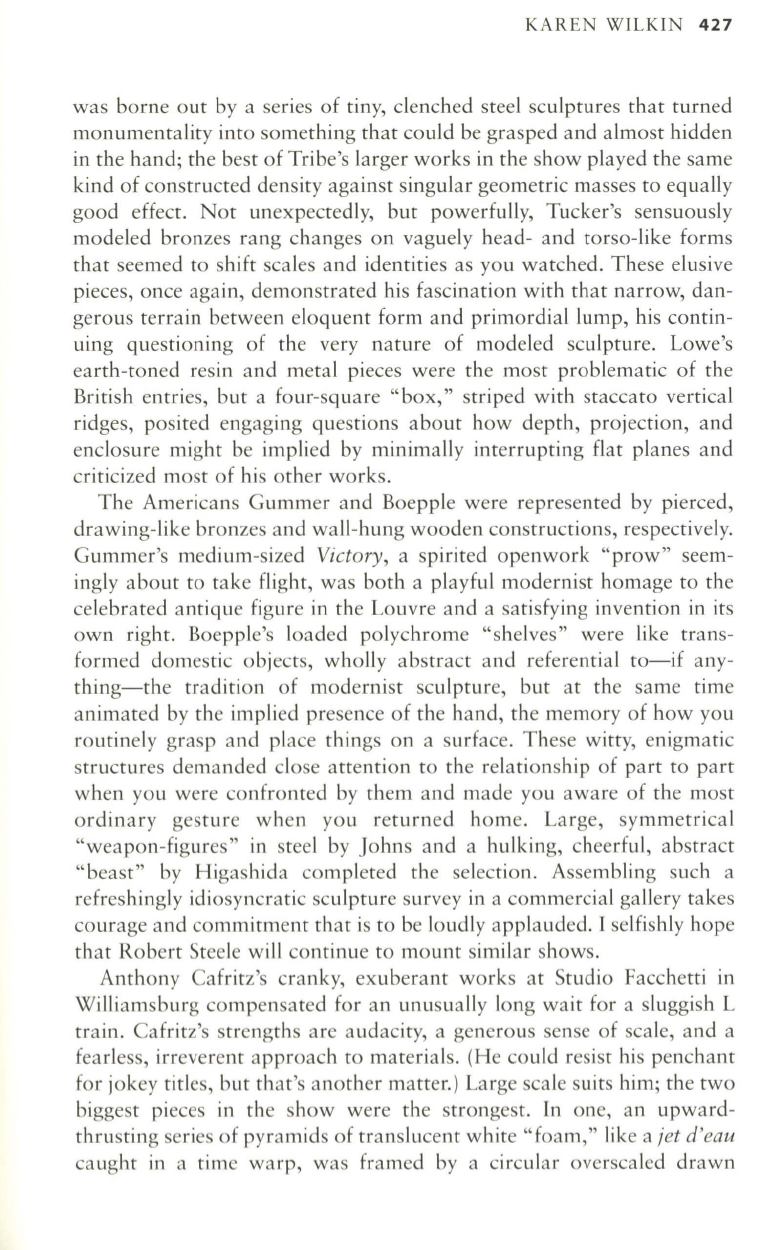
KAREN WILKIN
427
was borne out by a series of tiny, clenched steel sculptures that turned
monumentality into something that could be grasped and almost hidden
in the hand; the best of Tribe's larger works in the show played the same
kind of constructed density against singular geometric masses to equally
good effect. Not unexpectedly, but powerfully, Tucker's sensuously
modeled bronzes rang changes on vaguely head- and torso-like forms
that seemed to shift scales and identities as you watched. These elusive
pieces, once again, demonstrated his fascination with that narrow, dan–
gerous terrain between eloquent form and primordial lump, his contin–
uing questioning of the very nature of modeled sculpture. Lowe's
earth-toned resin and metal pieces were the most problematic of the
British entries, but a four-square "box," striped with staccato vertical
ridges, posited engaging questions about how depth, projection, and
enclosure might be implied by minimally interrupting flat planes and
criticized most of his other works.
The Americans Gummer and Boepple were represented by pierced,
drawing-like bronzes and wall-hung wooden constructions, respectively.
Gummer's medium-sized
Victory,
a spirited openwork "prow" seem–
ingly about to take flight, was both a playful modernist homage to the
celebrated antique figure in the Louvre and a satisfying invention in its
own right. Boepple's loaded polychrome "shelves" were like trans–
formed domestic objects, wholly abstract and referential to-if any–
thing-the tradition of modernist sculpture, but at the same time
animated by the implied presence of the hand, the memory of how you
routinely grasp and place things on a surface. These witty, enigmatic
structures demanded close attention to the relationship of part to part
when you were confronted by them and made you aware of the most
ordinary gesture when you returned home. Large, symmetrical
"weapon-figures" in steel by Johns and a hulking, cheerful, abstract
"beast" by Higashida completed the selection. Assembling such a
refreshingly idiosyncratic sculpture survey in a commercial gallery takes
courage and commitment that is to be loudly applauded. I selfishly hope
that Robert Steele will continue to mount similar shows.
Anthony Cafritz's cranky, exuberant works at Studio Facchetti in
Williamsburg compensated for an unusually long wait for a sluggish L
train. Cafritz's strengths are audacity, a generous sense of scale, and a
fearless, irreverent approach to materials. (He could resist his penchant
for jokey titles, but that's another matter.) Large scale suits him; the two
biggest pieces in the show were the strongest. In one, an upward–
thrusting series of pyramids of translucent white "foam," like a
jet d'eau
caught in a time warp, was framed by a circular overscaled drawn


